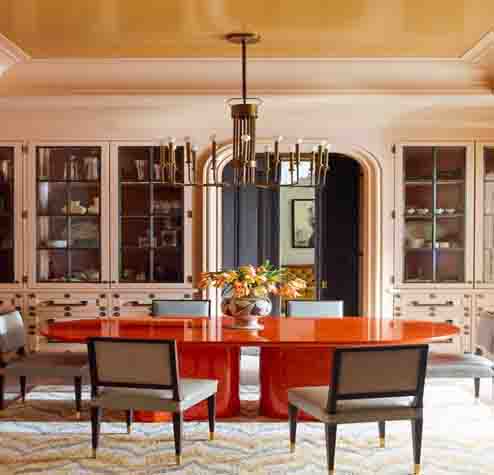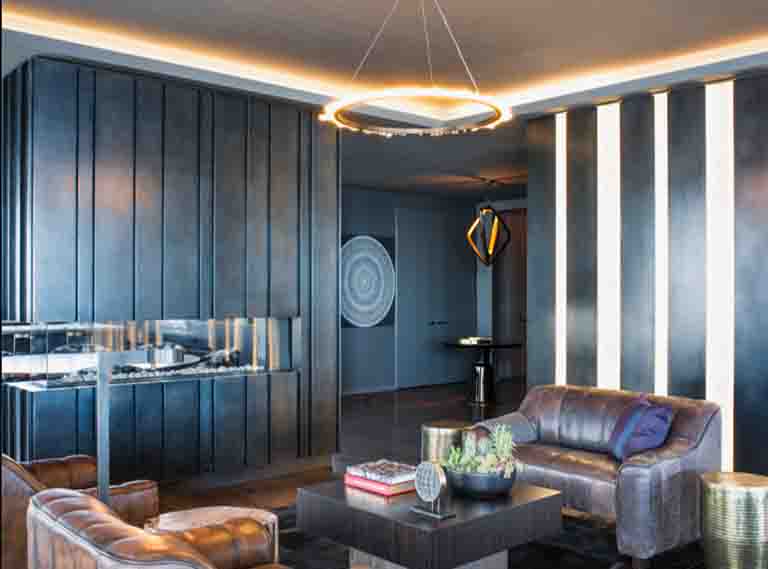Let's not sugarcoat things: When it comes to decorating a home, the ceiling is the most overlooked surface. Many of us spend so much time searching for a beautiful rug or perfect paint swatch that, save for choosing the right light fixture, we put little to no thought into our ceiling's design.
But bringing our home decor to new heights—and encouraging us to look up—is the tray ceiling. Also known as a recessed or inverted ceiling, the style boasts a center that's a few inches higher than the edges of the ceiling. Not only does this style add some visual interest to your ceiling, but it is also making a comeback. Want to add this option to your space? We're sharing everything you need to know about tray ceilings.

COFFERED CEILINGS VS. TRAY CEILINGS
A tray ceiling is very similar to a coffered ceiling, which dates back to the French Renaissance. But make no mistake; the two styles have several core differences. While coffered ceilings have multiple recessed sections, a tray ceiling is defined as having one, larger inverted area.
Additionally, coffered and tray ceilings serve different purposes. Beloved by designers and dwellers alike, coffered ceilings are known to improve a room's acoustics. Tray ceilings, on the other hand, are a clever way to mask the addition of a vent system in older homes. According to Bob Villa, the dropped down perimeter of a tray ceiling was designed to hide superfluous wires or plumbing in modern homes.
BENEFITS OF A TRAY CEILING
Tray ceilings aren't strictly practical: Simply put, this style also looks good. Not only does this option pair nicely with a range of architecture styles, but it also creates the illusion of high ceilings.
"Tray ceilings can bring dynamic design to any room," says interior designer Kendall Wilkinson. "They easily add a perceived sense of height to your space, which creates a luxurious feeling from the view below."
Plus, as HGTV reports, work that goes into installing a tray ceiling can ultimately add value to your home.

DRAWBACKS OF A TRAY CEILING
But before you add a tray ceiling or two to your home, consider the height of your ceilings. The drop-down border around the recessed tray can reduce headroom, which could make a smaller room feel claustrophobic. Alternatively, if you're considering a tray ceiling in a kitchen, the drop-down border can dictate the size of your cabinets. Err on the side of caution and measure your space. In fact, Bob Villa reports many building codes require a minimum ceiling height of eight feet before installing a tray ceiling.
Another drawback? Since tray ceilings have two distinctive heights, they may be slightly more difficult to paint and clean. However, the visual impact of tray ceilings will arguably make up for the any extra maintenance.
HOW TO CONSTRUCT A TRAY CEILING
Although installing a tray ceiling should be left to professionals, the construction process is surprisingly easy. To create the illusion of a high tray, contractors usually add wood to the perimeter room. Once the framework for the drop-down border has been installed, the wood is usually coated in drywall. A trim or molding can be added before painting the drywall.
While a tray ceiling can cost up to $1,500, home improvement service Kompare It claims a tray ceiling is considerably cheaper when it is installed during a home's construction.
HOW TO DECORATE A TRAY CEILING
While a tray ceiling can easily make a statement on its own, Wilkinson argues they can be treated as a blank canvas.
"[Tray ceilings] are a great opportunity to bring variation to otherwise flat spaces by adding in pops of color, patterned wallpaper, or textured trims to the layers and centers within," Wilkinson says." They're also a fun way to add modern lighting where more traditional fixtures, like chandeliers cannot, by running lights under their edges to create a glamorous glow.”
But no matter how you style a tray ceiling, one thing is for certain: Your space will make a statement from every angle.



















Your Message